![]()
![]()
![]()
Use LEFT and RIGHT arrow keys to navigate between flashcards;
Use UP and DOWN arrow keys to flip the card;
H to show hint;
A reads text to speech;
238 Cards in this Set
- Front
- Back
|
LECTURE 1 |
LECTURE 1 |
|
|
I. SCOPE OF MICROBIOLOGY |
I. SCOPE OF MICROBIOLOGY |
|
|
What is microbiology? |
The study of microorganisms |
|
|
What are some microorganisms? |
Bacteria, Algae, Protozoa, Helminths, Fungi, Viruses |
|
|
Prokaryotes: A. Means ________ B. Possess no _______ C. 2 types? |
A. Pre-nucleus B. nucleus C. Bacteria and Archaea |
|
|
Eukaryotes: A. Means _______ B. More ____ than prokaryotes C. Contains a ________ |
A. True Nucleus B. Complex C. nucleus |
|
|
Ubiquity: A. Present _______ B. _______ in size C. Populous in ______ numbers D. Live in ______ other organisms cannot |
A. everywhere B. small C. large D. places |
|
|
II. HISTORICAL FOUNDATIONS |
II. HISTORICAL FOUNDATIONS |
|
|
_______ ________ disproved the theory of Spontaneous Generation |
Louis Pasteur |
|
|
What two guys made first two microscopes? |
Robert Hooke and Antonie van Leeuwenhoek |
|
|
About Robert Hooke: A. What decade? B. Made _____ lens microscope C. Could view alive ______ structures |
A. 1660s B. single C. little |
|
|
About Antonie van Leeuwenhoek: A. Constructed over ___ small microscopes. B. Could magnify up to ___x. C. Described ________. |
A. 250 B. 300 C. "animalcules" |
|
|
Scientific Method: A. An experimental system developed to answer ______ objectively. B. Primary aim is to develop a testable _________ (should be a statement). C. Process of investigation is using _________, ________, and _________. D. The scientific method relies on a _______ _______. |
A. questions B. hypothesis C. observation, experimentation, reasoning D. testable hypothesis |
|
|
What does the Germ Theory of Disease state? |
some diseases are caused by microorganisms |
|
|
_______ _______ developed the aseptic techniques. |
Joseph Lister |
|
|
________ _______ developed pasteurization, the heating of certain foods/drinks (i.e. wine and beer) to kill microorganisms. |
Louis Pasteur |
|
|
_____ _____ developed Koch's postulates. |
Robert Koch |
|
|
There are ___ Postulates |
4 |
|
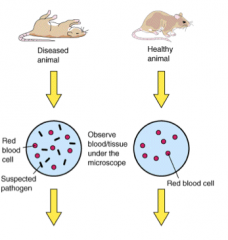
The first postulate states the pathogen should be __A.__ in all cases of disease and __B.__ from healthy animals. |
A. present B. absent |
|
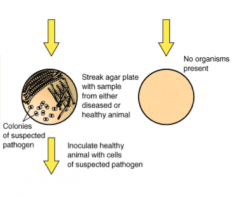
The second postulate states that the suspected organism should be grown in _____ ______. |
pure culture |
|
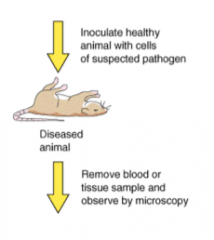
The third postulate states that cells from __A.__ _____ of suspected organism should cause disease in ___B.___ animals. |
A. pure culture B. healthy |
|
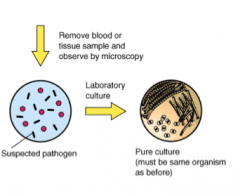
The fourth postulate states organism should be ______ and shown to be the same as the original. |
Reisolated |
|
|
III. MICROSCOPY |
III. MICROSCOPY |
|
|
What is resolution? |
Ability to distinguish two objects that are very close together as separate objects. |
|
|
What is focus? |
A means of moving the specimen closer or further away from the objective lens to render a sharp image |
|
|
What is parfocal? |
refers to objectives that can be changed with minimal or no refocusing |
|
|
Total Magnification equals A._______ _____ multiplied by the B.________ _____. |
A. ocular lens B. objective lens |
|
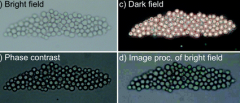
A. LIGHT MICROSCOPES |
A. LIGHT MICROSCOPES |
|
|
Brightfield Microscope: A. Most ______ microscope. B. Illuminates field of view ______ & ______. |
A. common B. entirely & evenly |
|
|
Darkfield Microscope: A. Light is directed ______ the specimen at an _______. B. ________ cells. C. Object is _____ and background is ______. |
A. toward, angle B. unstained C. bright, dark |
|
|
Phase Contrast Microscope: A. Makes _____ and other dense material appear ______ B. Does this by _____ slight differences between the refractive index of material and that of the surrounding material C. _______ cells D. _______ contrast |
A. cells, darker B. amplifying C. unstained D. increases |
|
|
Differential Interference Contrast Microscope: A. Images appear ___. B. Depends on differences in the ______ index. C. ______ cells. D. _______ contrast. |
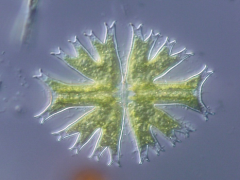
A. 3-D B. refractive C. Unstained D. Increases |
|
|
Fluorescence Microscope: A. Used to observe cells that are naturally _______ or have been stained or tagged with _______ dyes B. Project ___ light onto the specimen C. Fluorescence stands out against a ____ background |
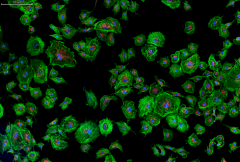
A. fluorescent, fluorescent B. UV C. dark |
|
|
B. ELECTRON MICROSCOPES |
B. ELECTRON MICROSCOPES |
|
|
Scanning Electron Microscope (SEM): A. _____ details. B. Beam of electrons scans _____ and _____. C. ______ is what is observed. |
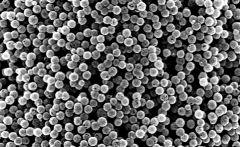
A. surface B. back and forth C. reflection |
|
|
Transmission Electron Microscope (TEM): A. Observes the _____ _____ of cell structure. B. Beam of electrons passes through the _______ or is _______. |

A. fine details B. specimen, scattered |
|
|
IV. Specimen Preparation |
IV. Specimen Preparation |
|
|
Staining; Increases ______ for observation. |
Contrast |
|
|
Types of Stains? |
Basic and Acidic |
|
|
Basic Stains: A. Have a ______ charge. B. Cells have a _______ charge. C. What do they use to stain? |
A. positive B. negative C. Methylene blue, Crystal violet, Safranin, Malachite green |
|
|
Acidic Stains: A. Have a _______ charge. B. _______ by cells because cells are ________. C. ______ background of slide. D. Used for ______ staining. |
A. negative B. repelled, negative C. stain D. negative |
|
|
Methods of Staining? |
Simple, Differential, Negative, Structural |
|
|
Simple Stain: A. ______ visualization of specimen B. Does _____ the organism through heat fixation. C. So, cannot be used for viewing _______. D. ______ and ____ procedure E. Uses a single ___ F. Best used for _______ G. Stains used: H. Reveals ____, _____, and _______. |
A. easier B. kill C. protozoans D. quick, easy E. dye F. morphology G. Methylene blue H. shape, size, arrangement |
|
|
Differential Stains: A. ________ one group from another B. Includes ____ stain and ___-____ stain |
A. distinguishes B. Gram, Acid-fast |
|
|
V. GRAM STAIN PROCEDURE |
V. GRAM STAIN PROCEDURE |
|
|
Gram Stain Procedure: A. Allows ______ visualization. B. Differentiations between Gram _____ and Gram ________ bacteria C. ________ procedure D. ______ margin of error |
A. easier B. positive, negative C. complicated D. Large |
|
|
Gram Stain Procedure Picture |

|
|
|
Acid-Fast Staining: A. ______ stain. B. Specific for _________ C. Contain mycolic acids in their ____ ____. |
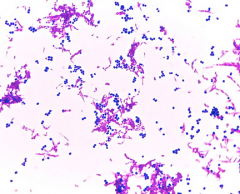
A. Differential B. Mycobacterium C. cell wall |
|
|
Endospore: A. _______ stain. B. Production of _________ C. Cell morphologies: D. Cell types: |
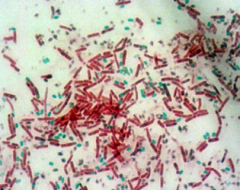
A. Structural B. endospores C. Bacillus and Clostridium D. vegetative, free spore, endospores |
|
|
VI. CELL MORPHOLOGY AND ARRANGEMENT |
VI. CELL MORPHOLOGY AND ARRANGEMENT |
|
|
A. Primary Cell morphologies: B. Other morphologies: |
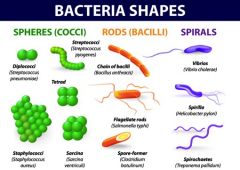
A. Coccus, Rod (bacillus), Vibrio/Spirals (curved rod) B. Spirillum, spirochete |
|
|
Cell Arrangements: A. Primary Arrangements: B. Additional Arrangements: |
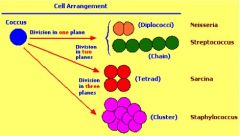
A. Chains, packets (tetrads), clusters B. Singles, tetrads, diplococci |
|
|
LECTURE 2 |
LECTURE 2 |
|
|
I. PROKARYOTIC SHAPES AND ARRANGEMENTS |
I. PROKARYOTIC SHAPES AND ARRANGEMENTS |
|
|
Most prokaryotes exist as ________ organisms. |
unicellular |
|
|
Sometimes, prokaryotes act as a group, in ________ or in _______. |
colonies, biofilms |
|
|
On average, prokaryotic cells are ___ microns. But, they can range from 0.05 to 0.2 microns to 750 microns. |
1. |
|
|
A. Prokaryotic cells of one species may vary in ____ and ____. B. This is called ______, caused by variations in cell wall structure. |
A. shape, size B. Pleomorphism |
|
|
A. Basic prokaryotic cell shapes? B. Unusual cell shapes? |
A. Cocci, Bacilli, Spiral (spirillum & spirochete)
B. star-shaped stella, square haloarcula, curved rod vibrio |
|
|
A. Most bacteria are __________ (maintain single shape). B. A few are _______ (more than one shape). |
A. Monomorphic B. Pleomorphic |
|
|
II. PROKARYOTIC FORM AND FUNCTION |
II. PROKARYOTIC FORM AND FUNCTION |
|
|
Prokaryotes can be distinguished by eukaryotes by: A. The way their ____ is packaged. B. The makeup of their ____ ____ of _______. C. Their ______ structure (lack of ______- ______ organelles) |
A. DNA B. Cell wall, peptidoglycan C. Internal, Membrane-bound |
|
|
All bacterial cells possess what 4 things? |
Cell membrane, cytoplasm, ribosomes, one (or a few) chromosome(s) |
|
|
Most bacterial cells possess what 2 things? |
A cell wall and surface coating called a GLYCOCALYX |
|
|
Some, but not all bacterial cells possess what 8 things? |
1. flagella 2. pili 3. fimbriae 4. an outer membrane 5. plasmids 6. inclusions 7. endospores 8. intracellular membranes |
|
|
Plasma Membrane (Innermost Layer): A. Possess _______ ________. B. ______ portion. C. No sterols (except mycoplasma), so less ____ than eukaryotic cell membranes. D. ______, ______, and _______ proteins. E. Selective ______ allows passage of some molecules but not others. F. ________ throughout membrane G. Some molecules require_____ or protein ______ in order to pass through. H. Enzymes for ____ production. I. Photosynthetic pigments on foldings (known as mesosome) called _________ or thylakoids. |
A. phospholipid bilayer B. interior C. rigid D. Peripheral, Integral, Transmembrane E. permeability F. selectivity G. porins, transporters H. ATP I. Chromatophores |
|
|
Movement Across Membranes: Simple Diffusion: movement of a solute from an area of __A__ concentration to an area of __B__ concentration. It diffuses ___C___ across the membrane. |
A. high B. low C. Freely |
|
|
Movement Across Membranes: Facilitative Diffusion: solute combines with a A. ______ ______ in the membrane. It DOES NOT require B. ______ or assistance across the membrane. |
A. transporter protein B. energy |
|
|
Movement Across Membranes: Osmosis: A. Movement of water across a _____ permeable membrane from an area of ____ water concentration to an area of _____ water concentration. Osmotic Pressure: B. The _______ needed to stop the movement of water across the ______. |
A. selectively, high, low B. pressure, membrane |
|
|
What are the 3 types of tonicity? |
Hypertonic, Hypotonic, Isotonic |
|
|
Hypertonic is when _____ moves ______ the cell, causing cytoplasm to shrink (plasmolysis) |
water, outside |
|
|
Hypotonic is when _____ moves ____ the cell and may cause cell to burst if wall is weak/damaged. |
water, into |
|
|
Isotonic is when there is __ ___ ______ of water. |
no net movement |
|
|
Movement Across Membranes: Active Transport A. Active Transport of substances requires a _______ protein and ____. B. Substance transported is NOT chemically _____. |
A. transporter, ATP B. altered |
|
|
Movement Across Membranes: Group Translocation A. Group Translocation of substances requires a ______ protein and ___(phosphoenolpyruvate). B. Substance transported is chemically _____ during transport. |
A. transporter, PEP B. altered |
|
|
Cell Wall: A. Prevent osmotic _____. B. Made of ________ (in bacteria). C. _______: Polymer of _______ N-acetylglucosamine (NAG) and N-acetylmuramic acid (NAM). D. Linked by _______ (amino acid chains). |
A. lysis B. peptidoglycan C. Petidogylcan, disaccharides D. Polypeptides |
|
|
Gram Staining: A. Staining technique used to _____ cells (bacteria) based on ____ ____ composition. B. Gram positive cells have ____ peptidoglycan layer, _____ lipid layer. C. Gram negative cells have _____ peptidoglycan layer, ____ lipid layer. |
A. differentiate, cell wall B. thick, thin (stain purple) C. thin, thick (stain red, pink) |
|
|
Gram-Positive Cell Walls: Teichoic Acids A. Lipoteichoic acid links to ______ ______. B. Wall teichoic acid links to _________. C. May regulate movement of _______. D. Polysaccharides provide ______ variation. |
A. plasma membrane B. peptidoglycan C. cations D. antigenic |
|
|
Gram-Negative Outer Membrane: A. Lipopolysaccharides, lipoproteins, ________. B. Forms the ______ between the outer membrane and the _______ membrane. C. Protection from _______, ________ (serum proteins promoting phagocytosis), and _______. D. Possess what 2 lipopolysaccharides? E. _____(proteins) forms channels through membrane. |
A. phospholipids B. periplasm, plasma C. phagocytes, complement, antibiotics D. O polysaccharide and Lipid A (endotoxin) E. Porins |
|
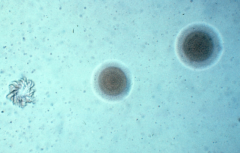
Atypical Cell Walls: Mycoplasmas: A. Lack ___ _____ B. ______ in plasma membrane |
A. cell walls B. Sterols |
|
|
Atypical Cell Walls: Archaea: A. Possess no _____ B. Walls of _____ (lack NAM and D amino acids) C. May appear gram _____ due to lack of _____ or do not gram stain at all. |
A. Walls B. pseudomurein C. Negative, peptidoglycan |
|
|
Atypical Cell Walls: Acid Fast Cells: A. Contain high concentration of _____ ____. B. _____ waxy substance. C. Prevents ____ uptake. D. Layers ____ of peptidoglycan E. Causes _____ of cells due to its sticky nature |
A. mycolic acid B. hydrophobic C. dye D. outside E. Clumping |
|
|
Glycocalyx: A. Viscous, gelatinous polymer external to cell wall. Usually composed of ______, ______, or a combination of both. B. Makes up _____ of cell wall. C. Always present? D. Usually _____. E. Organized glycocalyx described as a ______. F. Determined through ______ staining. G. A slime layer is _____ and _____. H. Capsules prevent phagocytosis: This contributes to _______. I. Extracellular Polysaccharide (EPS)- Glycocalyx composed of only sugars enabling _____ for survival. |
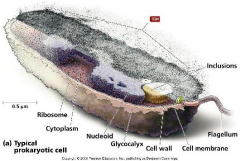
A. polysaccharides, polypeptides B. Outside C. no D. sticky E. capsule F. Negative G. unorganized, loose H. Virulence I. Attachment |
|
|
Cytoplasm: A. Cytoplasm is the substance ____ the plasma membrane. B. Thick and _____. C. Contains water, proteins, ______, carbohydrates, and ______. D. No _______ or cytoplasmic streaming (as in eukaryotes) |
A. inside B. aqueous C. enzymes, lipids D. cytoskeleton |
|
|
A. Inclusion Types (7) B. Function of inclusions? |
A. 1. Volutin 2. Polysaccharide Granules 3. Lipid Inclusions 4. Sulfur granules 5. Carboxysomes 6. Gas vacuoles 7. Magnetosomes B. Energy Reserves |
|
|
Nuclear Area (Nucleoid): A. Not _____ bound. B. Contains ____ in helical form, no ________. C. Known as ______ chromosome. D. Can be _____, oval or dumb bell shaped (any) |
A. membrane B. DNA, histones C. bacterial D. round |
|
|
Ribosomes: A. Smaller in ______ (70S) than in eukaryotes (80S). B. Function in _____ synthesis C. Located in ____ and ____ endoplasmic reticulum D. Only functional when ____ together with mRNA. |
A. prokaryotes B. Protein C. cytoplasm, rough D. bound |
|
|
External Structures: A. Fimbriae allow ________. B. Aids in bacterial _________. |
A. attachment B. colonization |
|
|
External Structures: A. Pili are used to ______ ___ from one cell to another (conjugation). B. ______ than fimbriae |
A. transfer DNA B. longer |
|
|
External Structures: A. Flagella are ____, filamentous appendages for ______. B. ______ the cell wall. C. Attached to a _____ hook. D. Anchored to the wall and membrane by the _____ _____. E. 3 Basic parts: |
A. long, motility B. outside C. protein D. basal body E. Filament, Hook, Basal body |
|
|
Motile Cells: A. Rotate flagella to ___ or _____. B. Via rotation of _____ body. C. Clockwise or _____-clockwise. D. Requires ______. E. Move _____ or ____ from stimuli (taxis) |
A. run, tumble B. basal C. counter D. energy E. toward, away (Chemotaxis, Phototaxis) |
|
|
Endospores: A. _____ cells. B. Endospores form in response to harsh or _______ environmental conditions. C. Resistant to ______, heat, chemicals. D. Shapes are _____ and ______. E. Clostridium cause gangrene, ______, botulism F. Sporulation: Endospore Formation, Also known as _________. G. Germination: Return to ______ state. |
A. Resting B. unfavorable C. Desiccation D. Bacillus, Clostridium E. tetanus F. Sporogenesis G. Vegetative |
|
|
LECTURE 3 |
LECTURE 3 |
|
|
I. UPTAKE OF NUTRIENTS |
I. UPTAKE OF NUTRIENTS |
|
|
A. Microbes can only take in dissolved particles across a ________ permeable membrane. B. Some nutrients enter by ________ diffusion. C. Microorganisms ________ mechanisms. |
A. selectively B. passive C. transport |
|
|
A. Facilitated diffusion happens in ______ organisms. B. Active transport happens in _____ organisms. C. Group Translocation happens in _____ & _____. D. Endocytosis happens in _____ only. |
A. all B. all C. bacteria & archaea (prokarya) D. Eukarya |
|
|
Passive Diffusion: A. Molecules move from region of ______ concentration to one of ______ concentration between the cell's interior and the exterior. B. H2O2 and CO2 often move across _____ this way. C. It does not require _______ |
A. higher, lower B. membranes C. energy |
|
|
Facilitated Diffusion similar to passive diffusion: A. Movement of molecules ___ ___ energy dependent B. Direction of movement is from ____ to ____ concentration. C. Size of ________ gradient impacts _____ of uptake. |
A. is not B. high, low C. concentration, rate |
|
|
Facilitated Diffusion differs from passive diffusion: A. Uses _______ bound carrier molecules (permease) B. ______ concentration gradient is required for significant uptake of molecules. C. Effectively transports glycerol, sugar, and _____ ____. D. More prominent in _______ cells than in bacteria or archaea. |
A. membrane B. smaller C. amino acids D. eukaryotic |
|
|
Active Transport: A. _____ dependent process B. ____ or proton motive force used C. Concentrates molecules _____ cell. D. Involves _____ proteins (permeases) E. Carrier ______ effect is observed at ____ solute concentrations |
A. energy B. ATP C. inside D. carrier E. saturation, high |
|
|
ABC Transporters: A. Primary _____ transporters uses ATP. B. ___-______ cassette (ABC) transporters. C. Observed in ______, _____, and _______. |
A. active B. ATP-Binding C. bacteria, archaea, eukaryotes |
|
|
Secondary Active Transport: A. Major ______ superfamily. B. Use ____ gradients to contrasport substances C. protons D. Symport- two substances both move in the _____ direction. E. Antiport- two substances move in _____ directions. |
A. facilitator B. ion C. protons D. same E. opposite |
|
|
Group Translocation: A. Energy ______ transport that ______ modifies molecule B. Best known _________ system is phosphoenolpyruvate |
A. dependent, chemically B. translocation |
|
|
II. EUKARYOTIC MICROORGANISMS |
II. EUKARYOTIC MICROORGANISMS |
|
|
Eukaryotic Microorganisms: A. Prominent members of _________. B. Useful as ______ systems industry. C. Some are major human ________. D. Two groups of eukaryotes commonly possess microbial members? |
A. ecosystems B. model C. pathogens D. protists and fungi |
|
|
Common Features of Eukaryotic Cells: A. Membrane-______ nuclei. B. Membrane-bound _______ that perform specific functions. C. Intracytoplasmic membrane complex serves as _______ system. D. More structurally _____ and generally _____ than bacterial or archaeal cells. |
A. delimited B. organelles C. transport D. complex, larger |
|
|
III. EUKARYOTIC CELL ENVELOPES |
III. EUKARYOTIC CELL ENVELOPES |
|
|
Eukaryotic Cell Envelopes: A. Consists of the ______ membrane and all coverings external to it. B. Plasma membrane is a ______ bilayer. C. Major membrane lipids include phosphoglycerides, sphingolipids, and cholesterol, all of which contribute to ______ of membrane. D. __________ participate in variety of cellular processes. E. Unlike peptidoglycan in cell wall of bacteria and archaea, many eukaryotes _____ or have a chemically distinct cell wall. F. Cells walls of photosynthetic algae have _______, pectin, and silica. G. Cells walls of fungi consist of cellulose, ______, or glucan. |
Eukaryotic Cell Envelopes: A. plasma B. lipid C. strength D. microdomains E. lack F. cellulose G. chitin |
|
|
IV. THE CYTOPLASM OF EUKARYOTES |
IV. THE CYTOPLASM OF EUKARYOTES |
|
|
Cytoplasm of Eukaryotes: Consists of liquid, the cytosol, and many ________. |
organelles |
|
|
Cytoskeleton of Eukaryotes: A. Vast network of interconnected ______ within the cytoplasmic matrix B. Filaments that form the _______: microfilaments (actin), microtubules, intermediate filaments, and motor proteins. C. Plays a role in both cell _____ and _______. |
A. filaments B. cytoskeleton C. shape, movement |
|
|
Microfilaments in Eukaryotes: A. Small _____ filaments, 4 to 7 nm in diameter. B. Scattered within cytoplasmic matrix or organized into ______ and parallel arrays. C. Composed of ______ protein. D. Involved in cell _____ and shape changes. |
A. protein B. networks C. actin D. motion |
|
|
Intermediate Filaments in Eukaryotes: A. Heterogenous elements of the ________ ~10 nm in diameter. B. ______ and vimentin classes. C. Role in cell is _______. D. Play ______ role. E. Some shown to form nuclear ______. F. Others help link cells together to form ______. |
A. cytoskeleton B. keratin C. unclear D. structural E. lamina F. tissues |
|
|
Microtubules in Eukaryotes: A. Shaped like thin ________ ~25 nm in diameter of o- and B-tubulin. B. Help maintain cell ______. C. Involved with _______ in cell movements. D. Participate in intracellular _______ processes. |
A. cylinders B. shape C. microfilaments D. transport |
|
|
V. ORGANELLES OF THE SECRETORY AND ENDOCYTIC PATHWAYS |
V. ORGANELLES OF THE SECRETORY AND ENDOCYTIC PATHWAYS |
|
|
Secretory Endocytic Pathway: Intricate complex of membranous _______ and vesicles that _____ materials into the cell from outside, from inside to outside, and within the cell. |
organelles, move |
|
|
Endoplasmic Reticulum (ER): Irregular _______ of branching and fusing membranous tubules and flattened sacs. |
network |
|
|
Rough ER: A. _________ are attached. B. Synthesis of secreted proteins by ER-associated _______. |
A. ribosomes B. enzymes |
|
|
Smooth ER: A. _______ of ribosomes. B. Synthesis of ______ by ER-associated enzymes. |
A. devoid B. lipids |
|
|
Functions of ER: A. _______ proteins, lipids, and other materials within cell. B. Major site of cell membrane __________. |
A. transports B. synthesis |
|
|
Golgi Apparatus: A. Membranous organelle made of _____ on each other. B. ____ and _____ faces. C. Dictyosomes=stacks of _________. D. Involved in modification, _________, and secretion of materials |
A. cisternae B. cis, trans C. cisternae D. packaging |
|
|
Lysosomes: A. Membrane-bound vesicles found in most ________. B. Involved in intracellular _________. C. Contain _______, enzymes which hydrolyze molecules and function best under slightly acidic conditions. D. Maintain an _______ environment by pumping protons into their interior. |
A. eukaryotes B. digestion C. hydrolases D. acidic |
|
|
The Secretory Pathway: A. Used to ______ materials to various sites within the cell, as well as to either the plasma membrane or cell exterior. B. _______ destined for the cell membrane, endosomes, and lysosomes or secretion are synthesized by ______ on rough ER. C. Targeted to RER lumen and are released in small budding ________ from RER. |
A. move B. proteins, ribosomes C. vesicles |
|
|
The Secretory Pathway: D. Released in small ______ --> ___ face of Golgi apparatus --> ____ face of Golgi apparatus E. modification of proteins occurs in _____; targets protein for final destination. F. Transport vesicles released from ______ face of Golgi G. After release some vesicles deliver their contents to _____ and lysosomes. |
D. vesicles, cis, trans E. Golgi F. trans G. endosomes |
|
|
The Secretory Pathway: H. Two types of vesicles ______ proteins to cell membrane. I. Constitutive ______ to membrane. J. ______ vesicles in multicellular eukaryotes store proteins until signal to release. K. ______ assurance mechanism. |
H. deliver I. delivery J. secretory K. quality |
|
|
The Secretory Pathway: L. _____ or ______ proteins are secreted into cytosol, targeted for destruction by ubiquitin polypeptides. M. Proteasomes _____ targeted proteins. |
L. unfolded, misfolded M. destroy |
|
|
The Endocytic Pathway: Endocytosis: A. used by all ______ cells B. used to bring ______ into the cell C. solutes or particles taken up and ______ in vesicles pinched from plasma membrane D. in most cases materials are then _____ to lysosome and destroyed. |
A. eukaryotic B. materials C. enclosed D. delivered |
|
|
Types of Endocytosis: Phagocytosis: use of cell surface protrusions to surround and ______ particles. |
engulf |
|
|
Type of Endocytosis: Clathrin-dependent (Receptor-Mediated): clathrin protein-coated pits have external receptors that specifically bind _________. |
macromolecules |
|
|
Type of Endocytosis: Caveolae-dependent endocytosis: may play role in _________ transduction, transport or small as well as macromolecules. |
signal |
|
|
Autophagy A. Delivery of materials to be _______ by route that does not involve endocytosis. B. Macroautophagy involves digestion and _______ of cytoplasmic components. C. _____ membrane surrounds cell component forming an autophagosome. D. Autophagosome _____ with a lysosome. |
A. digested B. recycling C. double D. fuses |
|
|
Once Lysosome Is Formed: A. Digestion occurs _______ release of lysosome enzymes into cytoplasmic matrix. B. As contents are digested, products leave the lysosome and can be used as _______. C. Resulting lysosome called a ______ ____ which can release contents to cell exterior by process called lysosome secretion. |
A. without B. nutrients C. residual body |
|
|
VI. ORGANELLES INVOLVED IN GENETIC CONTROL OF THE CELL |
VI. ORGANELLES INVOLVED IN GENETIC CONTROL OF THE CELL |
|
|
The Nucleus: A. Membrane-bound spherical structure that houses _______ material of eukaryotic cell. B. Contains dense fibrous material called ______. C. complex of DNA, histones, and other ______. D. five types of ______ form nucleosomes. E. The 5 types of histones are? F. chromatin condenses into ________ during division. |
A. genetic B. chromatin C. proteins D. histones E. H1, H2A, H2B, H3, H4 F. chromosomes |
|
|
Nuclear Envelope: A. _______ membrane structure that delimits nucleus. B. ______ with ER C. Penetrated by nuclear _____. D. associated proteins make up the nuclear _____ complex. E. pores allow materials to be _____ into or out of nucleus |
A. double B. continuous C. pores D. pore E. transported |
|
|
The Nucleolus: A. Organelle but not membrane ________. B. Important in ________ synthesis C. Directs _____ and processing of rRNA. D. Directs assembly of ____ to form partial ribosomal subunits. E. Ribosomes ______ in cytoplasm |
A. enclosed B. ribosome C. synthesis D. rRNA E. mature |
|
|
Eukaryotic Ribosomes: A. ______ than the 70S bacterial and archaeal ribosomes. B. __S in size C. __S + __S subunits D. May be attached to ER or free in ______ matrix E. 60S is ____ subunit to ER |
A. larger B. 80 C. 60, 40 D. cytoplasmic E. bound |
|
|
Eukaryotic Ribosomes: F. Protein made on ribosomes of RER are often ______ or ______ into ER membrane as integral membrane. G. Free _______ synthesize nonsecretory and nonmembrane proteins. |
F. secreted, inserted G. ribosomes |
|
|
3 Organelles involved in energy conservation? |
Mitochondria, Hydrogenosomes, Chloroplasts |
|
|
Endosymbiotic Hypothesis: A. Mitochondria, hydrogenosomes, and chloroplasts are all thought to have _____ from bacterial cells that invaded or were ingested by early ancestors of eukaryotic cells. B. Mitochondria and chloroplasts are very similar to ______ bacteria and cyanobacteria, respectively. |
A. evolved B. extant |
|
|
Mitochondria: A. "The ______ ______ of the cell" are found in most eukaryotic cells B. Site of tricarboxylic acid ____ activity C. Site where ___ is generated by electron transport and oxidative phosphorylation D. About the same size as _____ cells E. Reproduce by ______ ______ as do bacterial cells. |
A. Power House B. cycle C. ATP D. bacterial E. binary fission |
|
|
Mitochondrial Structure: Outer Membrane: Contains ____ similar to the outer membrane of Gram-negative bacteria |
porins |
|
|
Mitochondrial Structure: Inner Membrane: A. highly _____ to form cristae B. location of enzymes and electron _____ for electron transport and oxidative phosphorylation. |
A. folded B. carriers |
|
|
Mitochondrial Structure: Matrix: A. Matrix enclosed by _____ membrane B. Contains ______ and ________ DNA C. Contains ______ of the tricarboxylic acid cycle and enzymes involved in catabolism of ____ ____ |
A. inner B. ribosomes, mitochondrial C. ribosomes, fatty acids |
|
|
Hydrogenosomes: A. Small energy conservation organelles in some anaerobic ______ B. Descended from common ______ ancestor C. Double membrane, no cristae, usually lack ___ |
A. protists B. mitochondrial C. DNA |
|
|
Hydrogenosomes: D. ATP is generated by _____ process rather than respiration E. CO2, H2, and acetate are _______ |
D. fermentation E. products |
|
|
Chloroplasts: A. Type of ______ B. pigment-containing organelles observed in ____ and _____ C. Site of ______ reactions D. Surrounded by ______ membrane |
A. plastid B. plants, algae C. photosynthetic D. double |
|
|
Chloroplast Structure: A. The _____ (a matrix) is within inner membrane B. Contains, DNA, ______, lipid droplets, starch granules, and thylakoids. C. 2 steps of photosynthesis: |
A. stroma B. ribosomes C. Light and Dark reactions |
|
|
Thylakoids: A. ______, membrane-delimited sacs B. Grana= stacks of ________ C. _____ is site of light reactions D. _____ is site of dark reactions E. Algal chloroplasts may contain a ______ F. Participates in _______ synthesis |
A. flattened B. thylakoids C. Thylakoids D. Stroma E. pyrenoid F. polysaccharide |
|
|
VII: EXTERNAL CELL COVERING |
VII: EXTERNAL CELL COVERING |
|
|
Flagella: A. ___ to ___ um long B. move in ______ fashion |
A. 100, 200 B. undulating |
|
|
Cilia: A. _ to __ um long B. beat with ____ phases working like oars |
A. 5, 20 B. two |
|
|
Ultrastructure of Flagella and Cilia: A. Membrane-bound cylinders _ um in diameter. B. ______: set of microtubules in a _+_ arrangement Basal Body: C. at ____ of flagellum or cilium D. directs _____ of flagella and cilia |
A. 2 B. Axoneme, 9+2 C. base D. synthesis |
|
|
LECTURE 4 |
LECTURE 4 |
|
|
I. REPRODUCTIVE STRATEGIES |
I. REPRODUCTIVE STRATEGIES |
|
|
Reproductive strategies of eukaryotic microbes? |
Asexual, Sexual, haploid or diploid |
|
|
Bacteria and Archaea: A. ______ only, asexual- binary fission, budding, filamentous B. All must replicate and segregate the _____ prior to division |
A. haploid B. genome |
|
|
II. BACTERIAL CELL CYCLE |
II. BACTERIAL CELL CYCLE |
|
|
Bacterial Cell Cycle: A. Cell _____ is sequence of events from formation of new cell through the next cell division B. Most bacteria divide by _____ fission C. 2 pathways function during cycle? |
A. cycle B. binary C. DNA replication and partition, Cytokinesis |
|
|
Chromosome Replication and Partitioning: A. Most bacterial chromosomes are _______ B. Simple _____ of replication- site at which replication begins C. Terminus- site at which replication is ______, located opposite of the origin |
A. circular B. origin C. terminated |
|
|
Chromosome Replication and Partitioning: D. Replisome- group of ______ needed for DNA E. DNA replication proceeds in ____ directions from the origin F. Origins move to _____ ends of the cell |
D. proteins E. both F. opposite |
|
|
Chromosome Replication and Partitioning: G. Replisome pushes, or condensation of, daughter chromosome to opposite ____. H. MreB (murein cluster B)- an actin homolog, plays role in _______ of cell shape as spiral inside cell periphery, and chromosome segregation I. new _____ associate with MreB tracks |
G. ends
H. determination I. segregate |
|
|
Cytokinesis-Septation: A. _______- formation of cross walls between daughter cells. Several steps B. _______ of site for septum formation C. assembly of _ ring D. linkage of _ ring to ______ membrane (cell wall) E. Assembly of ____ ____ synthesizing machinery (CRITICAL STEP) F. Constriction of cell and ______ formation |
A. Septation B. selection C. Z D. Z, plasma E. Cell Wall F. septum |
|
|
Cellular Growth and Determination of Cell Shape: A. Determined by _________ synthesis in bacteria B. Penicillin _______ proteins (PBPs)- link peptidoglycan strands and catalyze controlled degradation for new growth C. _______- PBP enzymes that degrade peptidoglycan and site new units added |
A. peptidoglycan B. binding C. autolysins |
|
|
III. THE INFLUENCE OF ENVIRONMENTAL FACTORS ON GROWTH |
III. THE INFLUENCE OF ENVIRONMENTAL FACTORS ON GROWTH |
|
|
The Influence of Environmental Factors on Growth: A. Most organisms grow in fairly ______ environmental conditions Extremophiles B. Grow under _____ conditions that would kill most other organisms |
A. moderate B. harsh |
|
|
Solute and Water Activity: Changes in ______ concentration in the environment may affect microbial cells |
osmotic |
|
|
Hypotonic Solution (lower osmotic concentration): A. water _____ the cell B. cell swells may _____ |
A. enters B. burst |
|
|
Hypertonic Solution (higher osmotic concentration): A. Water ____ the cell B. membrane ______ from the cell wall (plasmolysis) may occur |
A. leaves B. shrinks |
|
|
Reduce osmotic concentration of cytoplasm in _________ solution. (MS channels in plasma membrane allow solutes to leave) |
hypotonic |
|
|
MicrobesAdapt to Changes in Osmotic Concentrations: A. Increase ______ solute concentration with compatible solutes to increase their internal osmotic concentration in hypertonic solutions B. Solutes compatible with metabolism and ______. |
A. internal B. growth |
|
|
Extremely Adapted Microbes: A. ________: grow optimally in presence of NaCl or other salts at a concentration above about 0.2M. |
A. Halophiles |
|
|
Extremely Adapted Microbes: Extreme halophiles: A. require ___ concentrations of 2M and 6.2M B. extremely ____ concentrations of potassium C. cell wall, proteins, and plasma membrane require high salt to maintain ______ and activity |
A. salt B. high C. stability |
|
|
pH A. measure of the relative _____ of a solution. B. negative logarithm of the hydrogen ____ concentration |
A. acidity B. ion |
|
|
__________- growth optimum between pH 0 and ph 5.5 |
Acidophiles |
|
|
________- growth optimum between pH 5.5 and pH 7 |
Neutrophiles |
|
|
_______- growth optimum between pH 8.5 and pH 11.5 |
Alkaliphiles |
|
|
A. Most microbes maintain an internal pH near ________ B. the plasma membrane is ________ to proton C. exchange _______ for protons |
A. neutrality B. impermeable (not allowing fluid to pass through) C. potassium |
|
|
Acidic Tolerance Response: A. pump protons ____ of cell B. some synthesize acid and heat shock proteins that protect ______ C. many microorganisms ______ the pH of their habitat by producing acidic or basic waste products |
A. out B. proteins C. change |
|
|
Temperature: A. Microbes cannot ________ their internal temperature B. Enzymes have _____ temperature at which they function optimally C. High temperatures may _____ enzyme functioning and be lethal D. Organisms exhibit 3 distinct cardinal growth temperatures: |
A. regulate B. optimal C. inhibit D. minimal, maximal, optimal |
|
|
Adaptations of Thermophiles: A. Protein structure _______ by a variety of means, like; 1) more H bonds 2) more prolines 3) chaperones B. ______- like proteins stabilize DNA C. Membrane _______ by variety of means, like; 1) more saturated, more branched and higher molecular weight lipids 2) ether linkages (archaeal membranes) |
A. stabilized B. histones C. stabilized |
|
|
Oxygen Concentration: 1. Aerobe: grows in _______ of atmospheric oxygen (O2), which is 20% O2 |
presence |
|
|
Oxygen Concentration: 2. Obligate aerobe: _______ O2 |
require |
|
|
Oxygen Concentration: 3. Obligate anaerobe: usually _______ in presence of O2. |
killed |
|
|
Oxygen Concentration: 4. Microaerophiles: _______ 2-10% O2 |
requires |
|
|
Oxygen Concentration: 5. Facultative Anaerobe: do not require O2 but grow _______ in its presence. |
better |
|
|
Oxygen Concentration: 6. Aerotolerant Anaerobe: grow with or without _____ |
O2 |
|
|
Basis of Different Oxygen: Oxygen easily reduced to ______ reactive oxygen species (ROS) like; 1-superoxide radical 2-hydrogen peroxide 3-hydroxyl radical |
toxic |
|
|
Basis of Different Oxygen: Aerobes produce ______ enzymes 1-superoxide radical 2-catalase 3-peroxidase |
protective |
|
|
Strict Anaerobic Microbes: All _______ anaerobic microorganisms lack or have very low quantities of: 1-superoxide dismutase 2-catalase |
strict |
|
|
Strict Anaerobic Microbes: These microbes cannot _________ O2. |
tolerate |
|
|
Strict Anaerobic Microbes: A. Anaerobes must be grown _______ O2. B. work station with _______. C. _______ anaerobic system. |
A. without B. incubator C. gaspak (provide oxygen free system for growth) |
|
|
Radiation Damage: 1. Ionizing radiation: A. x-rays and _____ rays B. mutations --> _____(sterilization) C. Disrupts chemical _______ of many molecules, including DNA D. Damage may be repaired by DNA ______ mechanisms if small dose |
A. gamma B. death C. structure D. repair |
|
|
Radiation Damage: 2. Ultraviolet (UV) radiation: A. wavelength most effectively ______ by DNA is 260 nm B. mutations --> _____ C. Causes formation of _____ dimers in DNA D. Requires direct exposure on microbial ______ E. DNA ______ can be repaired by several repair mechanisms |
A. absorbed B. death C. thymine D. surface E. damage |
|
|
IV. MICROBIAL GROWTH IN NATURAL ENVIRONMENTS |
IV. MICROBIAL GROWTH IN NATURAL ENVIRONMENTS |
|
|
Microbial environments are ______, constantly changing, often contain low nutrient concentrations (oligotrophic environment) and may expose a microorganism to overlapping gradients of ______ and ______ factors. |
complex, nutrients, environmental |
|
|
Biofilms: A. Most microbes grow _______ to surfaces (sessile) rather than free floating (planktonic) B. These attached microbes are members of complex, _____ enclosed communities called a biofilm C. Biofilms are ______ in nature in water D. Can be formed on any conditioned ______ |
A. attached B. slime C. ubiquitous D. surface |
|
|
Biofilms: E. A ______ biofilm is a complex, dynamic community F. Heterogeneity is differences in ________ activity and locations of microbes G. Interactions occur among the attached _______ |
E. mature F. metabolic G. organisms |
|
|
Biofilms: H. ________ take place metabolically, DNA uptake and communication. I. The EPS and change in attached organisms' physiology ______ microbes from harmful agents like: J. __ light, antibiotics, antimicrobials |
H. exchanges I. protects J. UV |
|
|
Biofilms: K. When formed on _____ devices, such as implants, often lead to illness L. ______ off of organisms can result in combination of water phase above the biofilm such as in a drinking water system |
K. medical L. sloughing |
|
|
Cell to Cell Communication Within the Microbial Populations: A. Bacterial cells in biofilms communicate in a density-dependent manner called ____ sensing. B. Produce small proteins that increase in _______ as microbes replicate and convert a microbe to a competent state C. DNA ______ occurs, bacteriocins are released |
A. quorum B. concentration C. uptake |
|
|
Quorum Sensing: A. Acylhomoserine lactone (AHL) is an ______ molecule produced by many gram-negative organisms. B. diffuses ______ plasma membrane C. once inside the cell, induces ______ of target genes regulating a variety of functions |
A. autoinducer B. across C. expression |
|
|
Quorum Sensing: A. Processes regulated by quorum sensing ______ host-microbe interactions B. Symbiosis- Vibrio fischeri and ______ in squid C. Pathogenicity and increased ______ factor production D. ___ uptake for antibiotic resistance genes |
A. involve B. bioluminescence C. virulence D. DNA |
|
|
V. CULTURING MICROBES |
V. CULTURING MICROBES |
|
|
Culture Media: A. Need to ____, transport, and store microorganisms in the laboratory B. Culture media is solid, liquid, or _____ preparation C. Must contain all the _____ required by the organism for growth Classification: 1. constituents from which they are made 2. physical nature 3. function |
A. grow B. semisolid C. nutrients |
|
|
Defined Media: A. Media who's exact _________ composition is known. B. Usually contain _____ & _____ compounds |
A. chemical B. organic, inorganic |
|
|
Complex Media: A. Media that contains even just one _____ that is not ______ B. Usually contain _______ from plants, animals, or yeasts |
A. component, definable B. extracts |
|
|
Physical states of Media: 1. _____ Media- doesn't solidify Ex/ broths 2. _____ Media- at room temp has gel consistency 3. _____ Media- firm Ex/ agar |
1. Liquid 2. Semisolid 3. Solid |
|
|
Functional Types of Media: 1. ____ Media- for growth of a wide variety of organisms. 2. ____ Media- general purpose media supplemented by blood or other special nutrients Ex/ blood agar 3. ____ Media- selects for a certain or even species of bacteria, allowing certain types of organisms to grow, and inhibits the growth of others. |
1. General Purpose / Supportive 2. Enriched 3. Selective |
|
|
Functional Types of Media: 4. _____ Media- bacteria that require complex nutrients or growth factors to grow 5. ______ Media- distinguishes one group of bacteria from another |
4. Fastidious 5. Differential |
|
|
A. ________Media ingredients–Bile salts & crystal violet (Selects for Gram negatives) B. _____ Media ingredients–Lactose (Differentiates between lactose fermenters) |
A. Selective B. Differential |
|
|
__________ is the breakdown of red blood cells 3 types: 1. Alpha-Partial 2. Beta-Complete 3. Gamma-non |
Hemolysis |
|
|
VI. ISOLATION OF PURE CULTURES |
VI. ISOLATION OF PURE CULTURES |
|
|
Isolation of Pure Cultures: A. Population of cells arising from a ______ cell developed by Robert Koch B. Allows for the study of single type of microorganism in _____ culture C. Spread plate, streak plate, and pour plate are techniques used to ______ pure cultures. |
A. single B. mixed C. isolate |
|
|
The Streak Plate: A. Involves technique of _____ a mixture of cells on an agar surface so that individual cells are well separated from each other. B. Involves use of bacteriological _____ C. ______ bacteria out to get isolated or individual colonies D. Each cell can reproduce to form a ______ colony (visible growth or cluster or microorganisms) |
A. spreading B. loop C. Dilutes D. separate |
|
|
The Pour Plate: A. Sample is _______ diluted B. diluted samples are mixed with liquid ____ C. Mixture of cells and agar are _____ into sterile culture dishes |
A. serially B. agar C. poured |
|
|
The Spread Plate: A. Small volume of diluted _____ containing approx. 30-300 cells is transferred B. _____ evenly over surface with a sterile bent rod (Isolation technique) |
A. mixture B. spread |
|
|
Both the ______ and the _____ Plate techniques may be used to determine the number of viable microorganisms in an original sample |
Pour, Spread |
|
|
Microbial Growth on Solid Surfaces: A. Colony ______ that develop when microorganisms are grown on agar surfaces aid in identification B. Microbial growth in _____ is similar C. Differences in growth rate from ____ to center is due to: 1. Oxygen, nutrients, toxic wastes 2. Cells may be __D__ in some areas |
A. characteristics B. Biofilms C. edges D. dead |
|
|
VII. MICROBIAL GROWTH |
VII. MICROBIAL GROWTH |
|
|
Microbial Growth: Increase in cellular constituents that may result in: A. Increase in cell _____ B. Increase in cell _____ C. Growth refers to _____ growth rather than growth of individual cells |
A. number B. size C. population |
|
|
The Growth Curve: A. Observed when microorganisms are _____ in batch culture B. Usually plotted as logarithm of cell _____ versus time C. Has __ distinct phases |
A. cultivated B. number C. 4 (Lag, Exponential, Stationary, Senescence and Death Phases) |
|
|
Lag Phase: A. Cell synthesizing ____ components Examples: 1. to replenish spent materials 2. to adapt to new medium or other conditions B. _____ in length C. In some cases can be very short or even _____ |
A. new B. varies C. absent |
|
|
Exponential Phase: A. Also called ___ phase B. Rate of growth and division is _____ and maximal C. Population is most _____ in terms of chemical and physical properties during this phase |
A. log B. constant C. uniform |
|
|
Stationary Phase: A. Closed system population growth eventually ceases, total # of ____ cells remains constant B. Active cells ____ reproducing or reproductive rate is balanced by death rate; Reasons: C. Nutrient _______ D. Limited _____ availability E. Toxic _____ accumulation F. Critical _____ density reached |
A. viable B. stop C. limitation D. oxygen E. waste F. population |
|
|
Senescence and Death Phase: Two alternative hypotheses: A. Cells are ______ But Not Culturable (VBNC) B. Cells alive, but _______, capable of new growth when conditions are right |
A. Viable B. dormant |
|
|
Programmed Cell Death: fraction of the population genetically _____ to die |
programmed |
|
|
VIII. MEASUREMENT OF MICROBIAL GROWTH |
VIII. MEASUREMENT OF MICROBIAL GROWTH |
|
|
Measurement of Microbial Growth: Direct Measurement- Direct Cell Counts A. counting ______ B. electronic ______- flow cytometry C. on _____ filters |
A. chambers B. counters C. membrane |
|
|
Viable Counting Methods: Spread and Pour Plate Techniques: A. ______ sample of bacteria is spread over solid agar surface or mixed with agar and poured into Petri plate B. After incubation the #s of organisms are determined by counting the # of colonies multiplied by the ____ factor C. Results expressed as colony forming units or _____ |
A. diluted B. dilution C. CFUs |
|
|
Measurement of Cell Mass: 1. Dry Weight A. ____ consuming and not very sensitive 2. Quantity of a particular cell constituent Ex/ protein, DNA, ATP, or cholorphyll B. useful if amount of substance in each cell is ______ 3. Turbidometric measures (light scattering) C. Quick, ____, and sensitive |
A. time B. constant C. easy |
|
|
Which type of bacteria only infect a host when their immune system is compromised? |
Opportunistic Pathogen |
|
|
Mitochondria is most similar in function to _______. |
Chloroplasts (mitochondria producing ATP through the kreb cycle and choroloplast uses photosynthesis do produce glucose) (They are both rod-shaped, both are the main power sources of the organisms, both have their own ribosomes and DNA, both have double-membrane, and both are organelles) |
|
|
Which media is best used for isolating an unknown bacterium? |
Typic Soy Agar (General Purpose) |
|
|
Aseptic technique is a method of handling microorganisms and materials in a way that minimizes contamination. TRUE OR FALSE? |
True |
|
|
Prokaryotes can be distinguishes by eukaryotes in what 3 ways? |
1. Way DNA is packaged 2. Composition of cell wall 3. Internal organelles |
|
|
A. Where are lipids made? B. Where is ATP made? C. Where is cell membrane made? D. Where are proteins made? E. Where are ribosomes made? F. Where is polysaccharide synthesis? |
A. Smooth ER B. mitochondria C. ER D. ribosomes E. Nucelolus F. thylakoid |
|
|
A. Where does photosynthesis occur? B. Where do light reactions happen in chloroplast? C. where do dark reactions happen in chloroplast? |
A. chloroplast B. thylakoids C. stroma |

